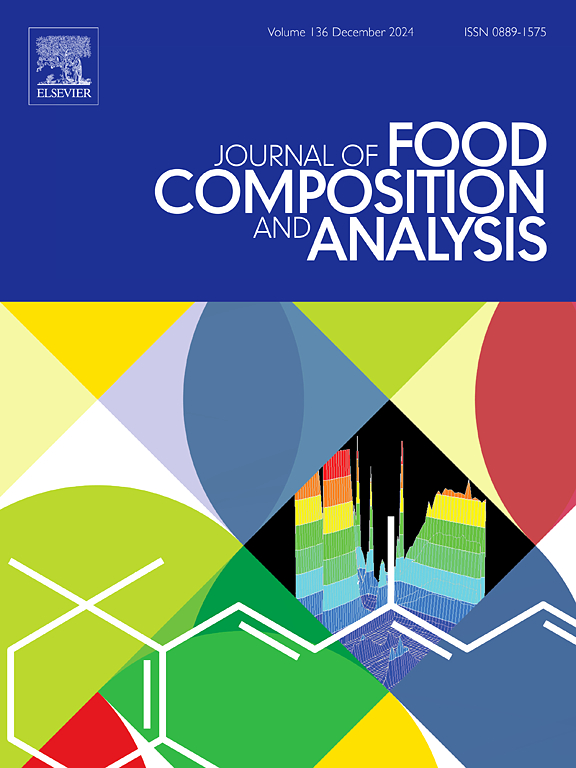Unveiling the origin and quality traits of Angelica sinensis: Hyperspectral imaging combined with chemometrics and information fusion strategies
IF 4.6
2区 农林科学
Q2 CHEMISTRY, APPLIED
引用次数: 0
Abstract
The quality of Angelica sinensis (Oliv.) Diels (AS) is strongly influenced by its geographical origin and the levels of key functional compounds, such as ferulic acid (FeA), levistilide A (LEA), and chlorogenic acid (CCA). This study aimed to develop non-destructive and rapid testing methods using hyperspectral imaging combined with chemometrics and information fusion strategies. Spectral data from the visible and near-infrared (VNIR) and short-wave infrared (SWIR) regions were collected from AS powder and slices. Hyperspectral data from an individual side effectively identified AS origins, with the partial least squares discriminant analysis (PLS-DA) model constructed by second derivative (SD) and data-level fusion, achieving 100 % accuracy in both training and testing sets. For quantitative regression models, back propagation neural network (BPNN) models demonstrated strong performance. Optimal predictions for FeA, LEA, and CCA were achieved using VNIR data (Rp² = 0.9287, RMSEp = 0.2244, RPD = 3.7285), data-level fusion (Rp² = 0.8302, RMSEp = 0.7983, RPD = 2.2463), and feature-level fusion using the competitive adaptive reweighted sampling (CARS) algorithm (Rp² = 0.8762, RMSEp = 0.7241, RPD = 2.6288), respectively. These findings demonstrate the effectiveness of hyperspectral imaging combined with chemometrics and fusion strategies for AS quality assessment, offering good prospects for real-world applications.
揭示当归的来源和品质性状:结合化学计量学和信息融合策略的高光谱成像
当归的质量Diels (AS)受其地理来源和关键功能化合物(如阿魏酸(FeA)、左维内酯A (LEA)和绿原酸(CCA))水平的强烈影响。本研究旨在发展结合化学计量学和信息融合策略的高光谱成像无损和快速检测方法。采集了AS粉末和薄片的可见光、近红外(VNIR)和短波红外(SWIR)光谱数据。利用二阶导数(SD)和数据级融合构建的偏最小二乘判别分析(PLS-DA)模型,来自单个侧的高光谱数据有效地识别出AS来源,在训练集和测试集上都达到了100% %的准确率。对于定量回归模型,反向传播神经网络(BPNN)模型表现出较强的性能。采用VNIR数据(Rp²= 0.9287,RMSEp = 0.2244, RPD = 3.7285)、数据级融合(Rp²= 0.8302,RMSEp = 0.7983, RPD = 2.2463)和竞争自适应重加权采样(CARS)算法(Rp²= 0.8762,RMSEp = 0.7241, RPD = 2.6288)分别对FeA、LEA和CCA进行了最优预测。这些发现证明了高光谱成像结合化学计量学和融合策略对AS质量评估的有效性,为实际应用提供了良好的前景。
本文章由计算机程序翻译,如有差异,请以英文原文为准。
求助全文
约1分钟内获得全文
求助全文
来源期刊

Journal of Food Composition and Analysis
工程技术-食品科技
CiteScore
6.20
自引率
11.60%
发文量
601
审稿时长
53 days
期刊介绍:
The Journal of Food Composition and Analysis publishes manuscripts on scientific aspects of data on the chemical composition of human foods, with particular emphasis on actual data on composition of foods; analytical methods; studies on the manipulation, storage, distribution and use of food composition data; and studies on the statistics, use and distribution of such data and data systems. The Journal''s basis is nutrient composition, with increasing emphasis on bioactive non-nutrient and anti-nutrient components. Papers must provide sufficient description of the food samples, analytical methods, quality control procedures and statistical treatments of the data to permit the end users of the food composition data to evaluate the appropriateness of such data in their projects.
The Journal does not publish papers on: microbiological compounds; sensory quality; aromatics/volatiles in food and wine; essential oils; organoleptic characteristics of food; physical properties; or clinical papers and pharmacology-related papers.
 求助内容:
求助内容: 应助结果提醒方式:
应助结果提醒方式:


